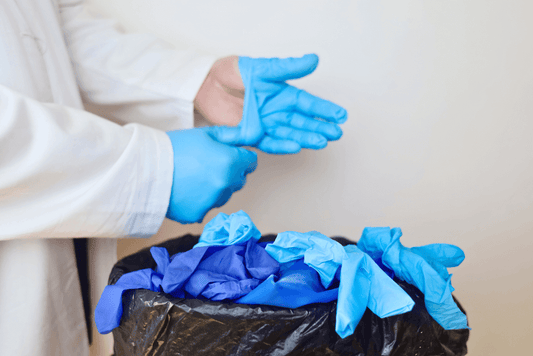How To Dispose of PPE Waste? Step-By-Step Guide
The rise in PPE usage has brought attention to how these materials are handled after use. Whether in healthcare, construction, or manufacturing, responsible disposal practices are necessary to reduce environmental load and safeguard public well-being. Not all waste should follow the same path. PPE waste, in particular, requires structured handling methods based on type, condition, and contamination level. This article outlines practical steps and sound strategies for proper PPE waste disposal, free from vague claims and full of purposeful guidance.
Understanding the Nature of PPE Waste
Personal protective equipment includes gloves, masks, goggles, face shields, gowns, shoe covers, and more. These items are often made of plastic polymers, rubbers, and treated fabrics. While they serve a protective purpose during use, they frequently become a burden afterward due to their limited reuse potential.
Used PPE is typically divided into two categories:
-
Contaminated PPE, such as medical masks or gloves used in healthcare settings.
-
Non-contaminated PPE, such as expired industrial workwear or unused surplus items.
Each category demands a different disposal approach. Applying one method across all PPE types often leads to unnecessary risks or lost material recovery opportunities.
Step-by-Step Guide to PPE Waste Disposal
1. Segregation and Collection
The first step is to collect PPE separately from general waste. Color-coded bins, lined with suitable waste bags, can make this process consistent across different facilities. Staff should be instructed on how to distinguish between clean and contaminated waste. Clear labeling helps avoid cross-contamination and simplifies downstream processes.
2. Identification and Sorting
Once collected, PPE should be sorted by material type and exposure risk. For example, nitrile gloves, surgical masks, and Tyvek suits all contain different base components. Some may be recyclable; others may require high-temperature treatment. Sorting also assists in choosing the most appropriate next steps-whether recycling, sterilisation, or disposal.
3. Recycling Where Feasible
Not all PPE is recyclable, but certain items-such as hard hats or non-woven polypropylene gowns-can be mechanically processed. Mechanical recycling involves shredding, cleaning, and melting the materials for use in new products. This reduces the demand for new resources and cuts down on overall landfill volume.
In some regions, chemical recycling offers another route. This involves breaking down PPE materials at the molecular level to create base chemicals that can be used in manufacturing. While more resource-intensive, it recovers materials from items that would otherwise be incinerated or buried.
4. Energy Recovery for Non-Recyclables
PPE that cannot be reused or recycled may still serve a purpose through energy recovery. This includes incineration in controlled environments where heat from combustion is converted into energy. Advanced energy-from-waste facilities operate under strict emission guidelines to limit air pollution and recover value from waste streams that have no other viable use.
5. Disposal of Contaminated PPE
Used PPE from healthcare environments or biohazard zones must be handled with caution. After collection, it should be placed in leak-proof containers and marked clearly. Transport should comply with regional waste handling regulations.
Sterilisation using autoclaves or chemical disinfectants may precede final disposal. In most cases, contaminated PPE is incinerated at high temperatures to neutralise biological hazards. This process is typically overseen by certified medical waste handlers.
Challenges in Disposal and How to Address Them
Volume Management
PPE waste volumes can fluctuate widely. During public health emergencies, volumes spike. Facilities need scalable systems in place. Partnering with waste service providers that offer flexible collection schedules can reduce backlog and maintain site hygiene.
Lack of Awareness
Staff may unknowingly dispose of reusable or recyclable PPE in general waste bins. Routine training sessions and on-site signage can support better habits. Simple visuals showing what goes where are often more effective than lengthy memos.
Limited Infrastructure
In many regions, recycling or recovery options for PPE are limited. This makes partnerships crucial. Working with organisations that specialise in industrial waste recycling can connect facilities with downstream handlers they wouldn't otherwise access.
What Businesses Can Do Now
-
Conduct a PPE Waste Audit
Map out what types of PPE your organisation uses, how much is discarded weekly, and where it ends up. This helps identify avoidable waste and opens opportunities for recovery. -
Work with Certified Handlers
Find waste service providers that hold relevant certifications for handling medical and industrial waste. Their compliance records and waste tracking systems contribute to transparency and accountability. -
Review Procurement Policies
Some suppliers offer PPE made from more recyclable materials or built-in end-of-life takeback programs. Switching suppliers may support your sustainability goals without disrupting operations. -
Educate Employees
Everyone involved in PPE use and disposal should understand the process. From warehouse staff to lab technicians, daily behavior shapes the effectiveness of waste programs. Education need not be complex-posters, brief walkthroughs, or short training clips can be enough.
Disposing of PPE is not just about removing used gear from the workplace. It’s about making responsible decisions at each stage-before purchase, during use, and after disposal. Facilities that adopt structured processes can reduce environmental burden while maintaining operational safety.
Incorporating recycling where feasible, relying on energy recovery when necessary, and staying informed about local regulations all contribute to a better outcome. Over time, these small adjustments lead to stronger systems that align with long-term sustainability goals.
PPE protects people during use. The way we dispose of it should do the same for the planet.
Partner with Earth Safe PPE to securely recycle used textiles and PPE through our trusted service. From garment shredding to certified destruction, we provide a reliable, eco-conscious solution that supports your organisation’s carbon reduction goals. Call us at +44 7482 212945 or visit our contact page.









